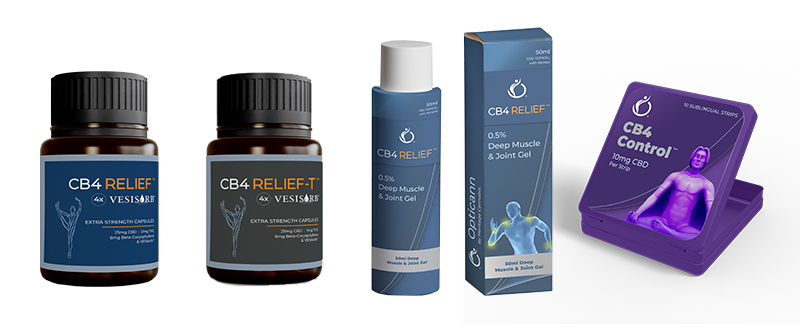New Hope in the Battle Against Chronic Pain

Relief from CBD is backed by clinical research
Do you or someone you know suffer from chronic pain? You are not alone; it’s more common than you think. As many as 1 of 4 Canadians over age 50 battles chronic pain.1,2 It’s a leading cause of disability globally and is a major factor in reducing the quality of life, decreased social connections and lost productivity.1,2,3
The two largest groups of chronic pain sufferers are those who suffer from pain due to an inflammatory state (e.g. arthritis) or injury to underlying tissue, and those who suffer from neuropathic pain that’s caused by nerve irritation or damage.
Cannabinoids are proven to play a role in relieving inflammatory and neuropathic pain.4 CBD (cannabidiol) and THC (tetrahydrocannabinol) are two common cannabinoids found in cannabis that help inhibit the sensation of pain.5 There’s accumulating evidence to support their use in treating chronic pain.6,7,8 CBD and THC may be a safe alternative as they do not have the risks and side-effects associated with opioids. Studies have also shown that when cannabinoids are used with opioids, the combination can result in a dramatic reduction in the dose of opioids needed to relieve pain.9,10,11
Multiple randomized control trial (RCT) results demonstrate CBD and THC efficacy in spasticity and pain for those suffering from multiple sclerosis and rheumatoid arthritis inflammatory pain.12 THC may play a greater role in treating neuropathic pain, while CBD is effective for reducing inflammation.7 Most trials showed pain reduction but higher oral THC doses were limited by THC side-effects (e.g. dysphoria, anxiety). However, increasing the CBD dose while limiting oral THC may result in better chronic pain relief, with fewer psychoactive and motor side-effects.
Scientific research shows how cannabinoids work: Cannabinoids affect the endocannabinoid system (ECS); which is involved in regulating inflammation and pain sensation. The ECS includes CB1 cannabinoid receptors, prevalent in the nervous system, and CB2 receptors, prevalent in the immune system. THC works on CB1 and CB2 receptors, whereas CBD has multiple pathways to decrease inflammation. CBD and THC also work synergistically with beta-caryophyllene (BCP), a terpene that binds to CB2 receptors to control inflammation.4,13

However, pharmaceutical technology is needed to increase oral CBD and THC absorption and to maximize effect. Only 8-12% of THC or CBD is absorbed into the bloodstream when taken by mouth. Better absorption increases the efficacy of both ingredients. Opticann uses patented pharmaceutical technology, VESIsorb®, in its CB4 Relief softgels with 25 mg CBD and 13 mg BCP. VESIsorb® is clinically proven to increase absorption by 440% (4.4x) and 3 times faster than conventional CBD capsules.14 CB4 Relief is a THC-free product best suited for daytime use. CB4 Relief-T softgels also contain low-dose THC (0.75 mg) for added effect and are suitable for nighttime use.
Breakthrough pain can be treated with quick-acting products. Opticann’s CB4 Control strips developed with VersaFilm® enable more rapid absorption from under the tongue (less than 5 minutes) compared to capsules and liquids. Each strip contains 10 mg CBD and less than 0.2 mg THC.
For localized use on the skin, CB4 Relief Deep Rub Topical Gel delivers CBD using technology proven to improve CBD penetration across the skin and into the tissue below for maximum and quick effect.
Get 15% off Opticann CB4 products by going to opticann.ca to book a quick telemedicine assessment by Opticann’s online clinic partner, Releave Therapeutics, to obtain a medical authorization. Opticann’s Patient Care Team will guide you through the registration process after your Releave Therapeutics appointment and can advise you on dosage, drug interactions and precautions.
CARP members receive 15% off all products purchased through opticann.ca.
References
1 Schopflocher, D. et al. (2011). The prevalence of chronic pain in Canada. Pain Res Manag, 16(6): 445–450. https://doi.org/10.1155/2011/876306
2 Health Canada. (2019). Chronic pain in Canada: Laying a foundation for action. https://www.canada.ca/en/health-canada/corporate/about-health-canada/public-engagement/external-advisory-bodies/canadian-pain-task-force/report-2019.html
3 The Lancet. (2021). Chronic pain. https://www.thelancet.com/series/chronic-pain
4 Fine, P.G. et al. (2013). The endocannabinoid system, cannabinoids, and pain. Rambam Maimonides Med J, 4(4): e0022. https://doi.org/10.5041/RMMJ.10129
5 Health Canada. (2018). Information for health care professionals: Cannabis (marihuana, marijuana) and the cannabinoids. https://www.canada.ca/en/health-canada/services/drugs-medication/cannabis/information-medical-practitioners/information-health-care-professionals-cannabis-cannabinoids.html
6 National Academies of Sciences, Engineering, and Medicine. (2017). The health effects of cannabis and cannabinoids: The current state of evidence and recommendations for research. https://doi.org/10.17226/24625
7 Whiting, P.F. et al. (2015). Cannabinoids for medical use: A systematic review and meta-analysis. JAMA, 313(24):2456-73. https://doi.org/10.1001/jama.2015.6358
8 Allan, G.M. et al. (2018). Simplified guideline for prescribing medical cannabinoids in primary care. Canadian Family Physician, 64: 111-20. https://www.cfp.ca/content/cfp/64/2/111.full.pdf
9 Haroutounian, S. et al. (2016). The effect of medicinal cannabis on pain and quality-of-life outcomes in chronic pain: A prospective open-label study. Clin J Pain, 32(12): 1036-43. https://doi.org/10.1097/AJP.0000000000000364
10 Capano, A. et al. (2020). Evaluation of the effects of CBD hemp extract on opioid use and quality of life indicators in chronic pain patients: A prospective cohort study. Postgraduate Medicine, 132(1): 56-61. https://doi.org/10.1080/00325481.2019.1685298
11 O’Connell, M. et al. (2019). Medical cannabis: Effects on opioid and benzodiazepine requirements for pain control. Annals of Pharmacotherapy,53(11): 1081-86. https://doi.org/10.1177/1060028019854221
12 Blake, D.R. et al. (2006). Preliminary assessment of the efficacy, tolerability and safety of a cannabis-based medicine (Sativex) in the treatment of pain caused by rheumatoid arthritis. Rheumatology, 45(1): 50-2. https://doi.org/10.1093/rheumatology/kei183
13 Scandiffio, R. et al. (2020). Protective effects of BCP in chronic inflammation. Nutrients, 12(11): 3273. https://doi.org/10.3390/nu12113273
14 Knaub, K. et al. (2019). A novel self-emulsifying drug delivery system (SEDDS) based on VESIsorb® formulation technology improving the oral bioavailability of cannabidiol in healthy subjects. Molecules, 24(16): 2967. https://doi.org/10.3390/molecules24162967
